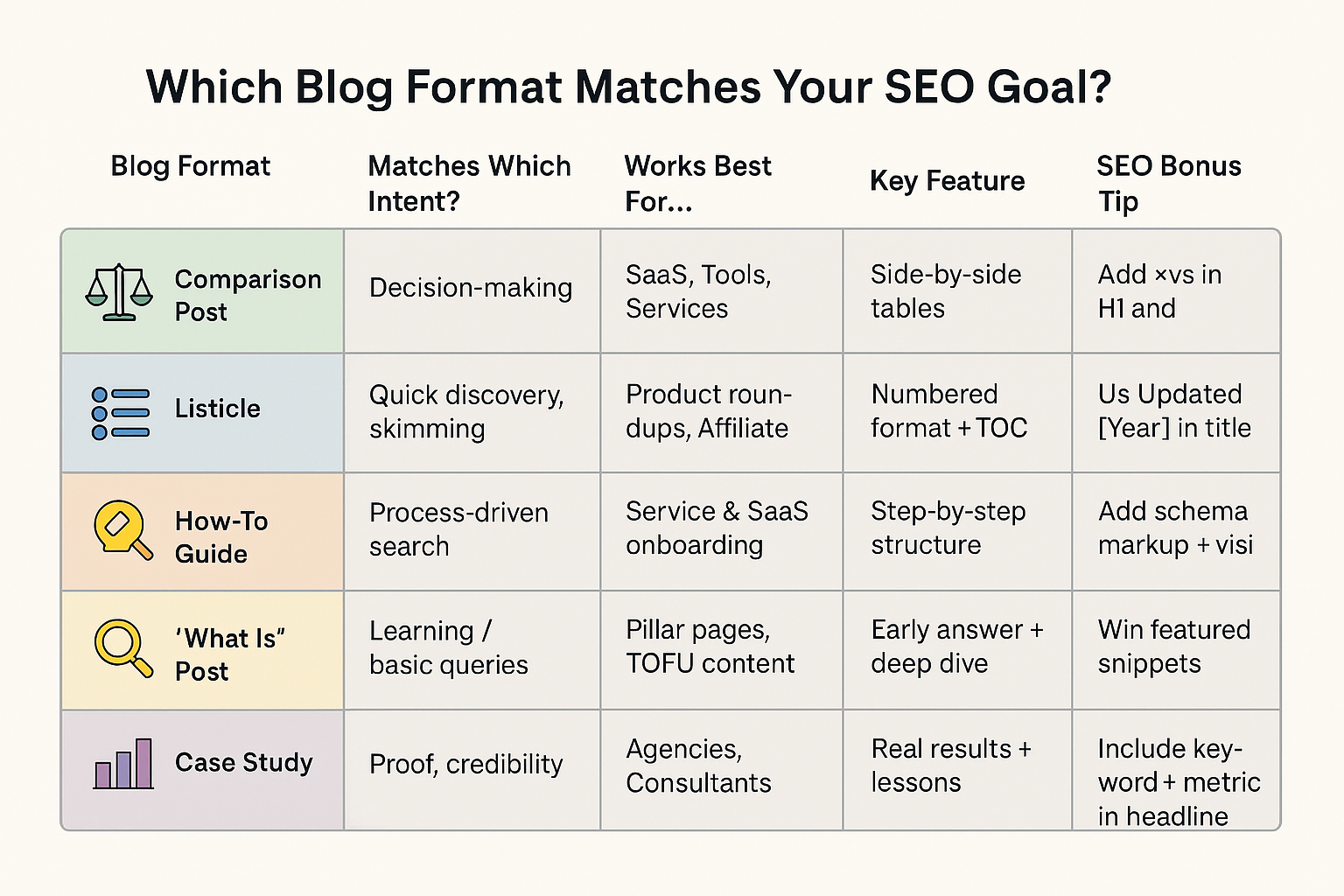Most blogs underperform for a simple reason: they’re written like essays, not search-driven assets.
Too much fluff. Too little structure. No clear match with user intent.
At 3MY, we’ve tested dozens of post types across industries. These 5 formats consistently outperform in search results — bringing in targeted traffic, reducing bounce, and generating qualified leads.
1. Comparison Posts (“X vs. Y”)
Why it works:
Buyers researching tools, services, or software often have one goal: decide between two options. Google loves when your content helps with that. The “[Tool] vs. [Tool]” structure aligns perfectly with mid-funnel decision intent.
Best for:
- SaaS tools
- B2B services
- Product alternatives
Strong examples:
- Notion vs. Evernote: Which One’s Right for Remote Teams?
- Shopify vs. WooCommerce: What Scales Better in 2025?
What to include:
- A side-by-side comparison table
- Key use cases for each option
- A “Who should choose what?” section
SEO tip:
Target long-tail keywords like “Is [Tool A] better than [Tool B]?” and feature a clear verdict to earn snippets.
2. Listicles (Numbered Resources or Mistakes)
Why it works:
Readers and algorithms love lists. They’re scannable, structured, and naturally align with “best,” “top,” or “tools for…” keyword patterns. They also drive shares and backlinks when done well.
Best for:
- Affiliate roundups
- Educational resources
- Lead magnets
Strong examples:
- 10 AI Tools Every Copywriter Should Try in 2025
- 7 Common Mistakes Founders Make When Hiring Developers
What to include:
- A dynamic table of contents
- Visuals or icons for each point
- A clear CTA at the end (email capture, trial, guide)
SEO tip:
Use “Updated for [Current Year]” in the title tag and intro. This boosts CTR and helps evergreen content stay relevant.
3. Step-by-Step How-To Posts
Why it works:
“How to” queries are high-intent and conversion-ready. They often include long-tail variations and match informational search perfectly. These posts build authority and reduce user hesitation.
Best for:
- Explainer content
- SaaS onboarding flows
- Technical services
Strong examples:
- How to Set Up Call Tracking in Google Ads (Step-by-Step)
- How to Build a High-Converting Landing Page in Webflow
What to include:
- Numbered steps
- Screenshots or video walkthroughs
- Bonus section with templates, tools, or downloadable checklists
SEO tip:
Add FAQ schema to answer follow-up questions directly on the SERP — and link to internal pages for deeper guidance.
4. “What Is” Definition + Deep Dive Posts
Why it works:
Top-of-funnel users search for definitions. These posts attract traffic, win snippets, and build topical authority when supported by strong internal linking.
Best for:
- SaaS blogs
- Marketing agencies
- Knowledge hubs
Strong examples:
- What Is Conversion Rate Optimization? A Beginner’s Guide with Examples
- What Is Structured Data? How It Helps Your SEO in 2025
What to include:
- Clear definition in the first 50 words
- Contextual examples and use cases
- Short FAQ or glossary at the bottom
SEO tip:
Answer the core question concisely, then expand into strategy, mistakes, tools, and trends. This turns a 300-word snippet into a 1500-word SEO pillar.
5. Case Study Breakdown (With Numbers)
Why it works:
Case studies show, not just tell. When backed by real metrics and outcomes, they earn trust, links, and direct inquiries. These posts are ideal for lead gen — even with low search volume.
Best for:
- Agencies
- Consultants
- DTC brands with unique strategies
Strong examples:
- How We Grew a SaaS Client’s Leads by 300% in 90 Days
- How a Shopify Redesign Cut Bounce Rate by Half
What to include:
- A challenge → process → result structure
- Real screenshots, dashboards, or timeline visuals
- A CTA to “get similar results”
SEO tip:
Include the keyword in your headline but keep it benefit-driven. E.g., “Case Study: [Keyword]” vs. “How We Boosted [Metric] with [Keyword Strategy]”.
Bonus: Don’t Mix Formats — Match Intent
Each post should focus on one goal:
- Teach something
- Compare options
- Convert through proof
Trying to combine too many functions — education, storytelling, product pitch — weakens all of them.
Pick a format. Stick to it. Execute well.

Quick reference: Match the right blog format to your SEO intent and business goal.
How 3MY Helps
At 3MY, we don’t just write blog posts.
We map intent, build structure, and design content that climbs SERPs and drives action.
Here’s how we do it:
- Content Format Strategy: We select the right format for your goals (TOFU/MOFU/BOFU)
- Topic + Keyword Planning: We target terms your buyers are actually searching — not just random blog ideas
- Optimized Writing: Clear structure, internal linking, table of contents, CTAs, and real examples
- Performance Tracking: You’ll see what’s ranking, converting, and ready for an update
Book a Blog Audit
We’ll review your current blog archive, assess ranking gaps, and recommend 3–5 high-performing formats to use in your next 90 days.
No fluff. Just structure, clarity and organic growth that compounds.










